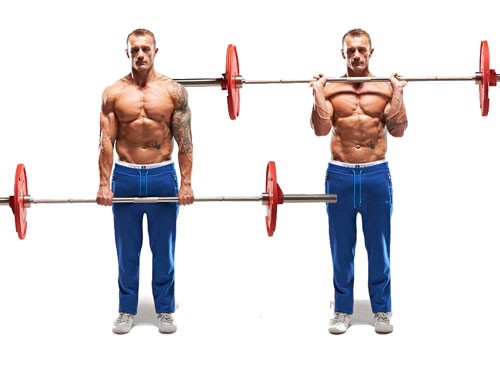The reverse barbell curl is a exercise that develops the brachioradialis, the muscle directly responsible for strengthening and developing the forearm. When done properly, the reverse curl is one most effective exercise you see being use at the gym for developing the forearm. Why not try this range of Workout Clothes to get the most from your exercise?
Barbell Reverse Curl Summary
- Main Muscle(s) Worked: Forearms Brachioradialis
- Other Muscles (Secondary) Worked: Biceps Brachii
- Equipment: Barbell
- Mechanics Type: Isolation (An exercise that involves one joint movement).
- Force: Pull (A movement toward centre of the body during the concentric contraction of the target muscle).
- Utility: Auxiliary (An optional exercise that may supplement a basic exercise. Auxiliary exercises may place greater relative intensity on a specific muscle or a head of a muscle).

Tips for Performing Barbell Reverse Curl
By using the tips mentioned below, it will help for the muscle(s) full development by incorporating more muscle fibres per rep, increasing the muscle’s size and strength.
- Practice proper form and control. Starting with this exercise, or any exercise you have not performed before, use light weight until you have the full range of movement with proper extension and contraction completed. This is important for the muscles full development.
- Keep elbows tight to your body. When elbows are fully flexed, the elbow should only move forward a few inches allowing the forearm to be no more than perpendicular to the floor.
- Keep your wrist in a lock position. Keep your wrist in a locked position throughout the movement.
- Move naturally throughout the movement. Move naturally throughout the movement by swaying your body slightly as you lift the barbell.
- Don’t move weight past tension point. It’s important not to curl the weight past the point where tension leaves the forearm and bicep.
- Use weight that allows smooth and controlled motion. This will avoid cheating which in turn will take the emphasis off the forearm.
Frequent Mistakes Made While Performing Barbell Reverse Curl
Performing the exercise improperly, often referred to as cheating, will not allow for the muscle and muscle fibres to be use their fullest potential, resulting in not achieving desired development of the muscle.
- Movement performed too fast. If movement is performed too fast, it will not allow full usage of all muscle fibres.
- Using too much weight. A mistake for many lifters is trying to lift too much weight. Make sure to use correct weight, without cheating, this will allow you to use proper form and full range of motion.
- Too much upper body movement. If you use your upper body as momentum (cheating) to help in lifting the weight you are partially defeating the lift and will not gain the muscle desired.
- Moving weight past tension point. If you move the weight past the tension point at top of movement, this will allow your forearm to rest, thus not allowing as mush muscular gains hoped for.
- Moving elbows to far forward. If elbows move to far forward this will allow the shoulders and back to lift the weight with minimal emphases put on the forearms.
- Elbows away from body. If elbows are away from your body you will incorporate other muscle groups such as biceps, shoulders and lats in helping with the lift, lessening the muscle gains this exercise was designed for.
Variations of Exercise or Equipment Use for Barbell Reverse Curl
A variation of a specific exercise is intended to work different subgroups of muscles, or work the same muscles in slightly different ways. There are many exercise variations to this strength exercise. Some of the variations use for reverse curl:
- Dumbbell Reverse Curl. Dumbbell reverse curl works the same way as the barbell reverse curl but with your forearms working independently of each other. The benefit with this exercise you can either lift the dumbbells at the same time or alternate arms. This is an excellent exercise for directly targeting the forearm (Brachioadialis).
- Barbell Reverse Preacher Curl. Your arms work together with the reverse preacher curl and performed the same as the preacher curl except palms are facing down. The benefit with this exercise, when performed correctly, arms are lock in place when resting on the pads and eliminates using the body to help with the lift.
- Cable Reverse Curl. Again, this performed the same as the cable curl but with palms facing the floor. The benefit with using cables, it’s easier to keep tension on the forearm throughout the movement.
- Lever Reverse Preacher Curl. Hold the handles with an overhand grip and curl up like you would a barbell reverse preacher curl. One of the differences about using a machine, most have handles that swivel allowing for wrist comfort, this can be beneficial if having any wrist problems. Like with the cable reverse curl this machine allows you to keep the tension on the forearm throughout the movement.

